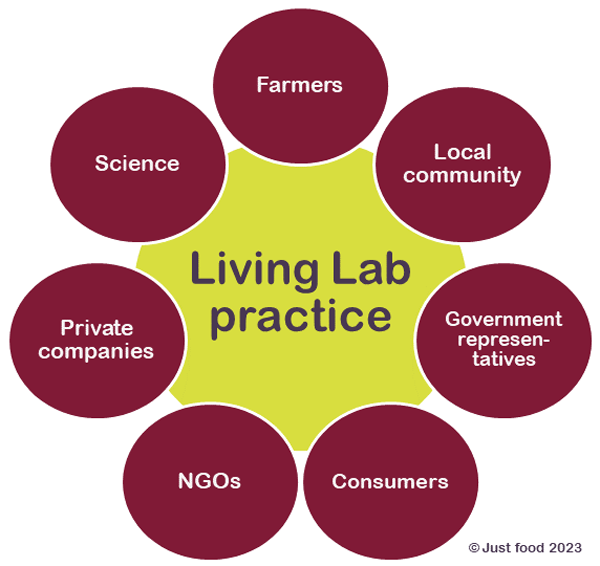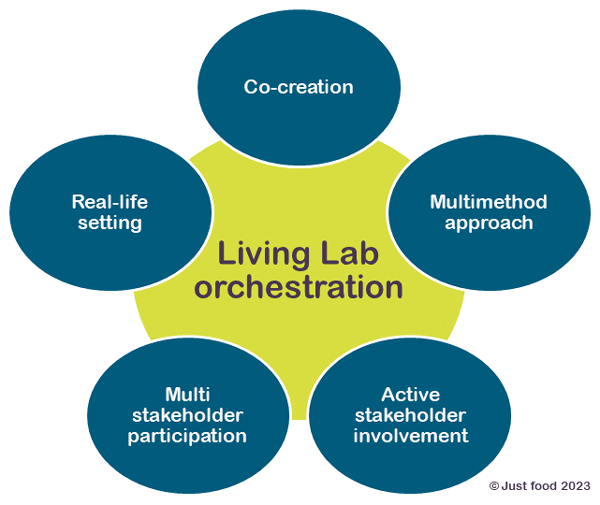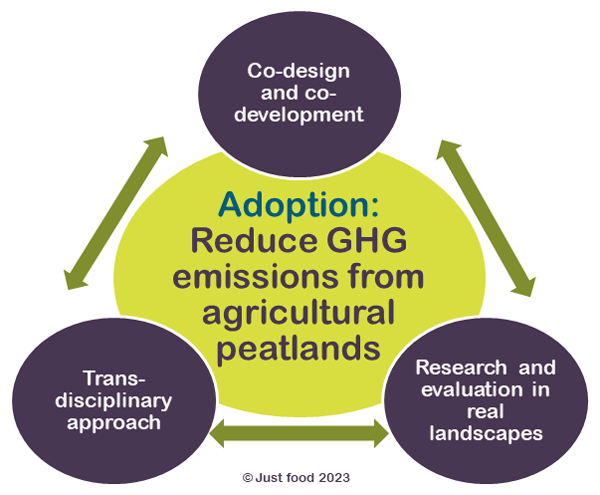The use of organic soils in food production is a complex and politically driven issue in Finland. It can only be addressed through interventions that account for local, regional, and national needs to generate transformative and system-wide change.
The living lab is for the co-creation of policy measures to mitigate greenhouse gas emissions from agricultural peatlands in Finland. The stakeholders of the living lab include farmers, local community, scientists, government representatives, private companies, NGOs, and consumers.
Practice

Living Lab stakeholders who are developing measures to mitigate greenhouse gas emissions from agricultural peatlands. © Just food
Co-creation & co-design
The objectives of the living lab are to identify and define incentives from both the public and private sectors and develop shared understanding between relevant actors in the food system for creating actions and related policy measures to significantly reduce GHG emissions from agricultural peatlands in Finland. The living lab is orchestrated by co-creation with multi-method approach as well as multi-stakeholder participation and active stakeholder involvement in a real-life setting.
This is to utilise transdisciplinary work for food system transformation and produce three principal outcomes for the food system – food & nutrition security, livelihoods and fair income, and environmental sustainability.
The living lab is an agroecosystem living lab with three components: transdisciplinary approaches, co-design and co-development component and research and evaluation in real landscapes.
Orchestration

The diagram’s concept originated from the European Network of Living Labs (ENoLL): the international, non-profit, independent association of benchmarked Living Labs. © Just food
Farmers and local community members are the core stakeholders of the living lab
Farmers’ knowledge of farming is built on their knowledge of their own land, thus instead of neglecting farmers’ knowledge, it can be used to build common understanding on the ideals of food production and what kinds of changes are possible at their farms. Flows of understanding also do not always necessarily go from the environmental authorities to the farmers, but it may be that farmers understand and interpret environmental measures better when they see other farmers' interpretations of them and interact with other farmers.
In general, farmers and family farms with a strong reputation as good farmers can more easily adopt new practices without losing their reputation and serve as an example to other farmers. The ideals of good farming, as well as acceptability, are therefore also the result of collective action. Many successful environmental measures have been the result of farmers' collective action. It may be easier for farmers to construct new ideals/meanings of good farming through social interaction. The farmers’ community is not only a social group where the farmer operates, but also a community where appreciation matters.
Food production will always be the most important goal of agriculture. However, farm practices together with environmental/climate-oriented knowledge and actions can create a variation of ideals for good farming. Local community members can create new meanings for good farming in order to achieve the goals for carbon neutrality in agriculture locally.
Adoption

The diagram’s concept is adapted from the results of the international Agroecosystems Living Laboratories (ALL) working group: representatives of national agricultural research institutes from 10 countries and the European Commission. © Just food
Research's implementation and timetable
The research and evaluation of the living lab is to be implemented in Valtimo, Nurmes, North Karelia. Participants are engaged in all phases of the living lab, including the identification of issues, innovation activities, and the evaluation of the living lab. Participation of farmers, local community, scientists, government representatives, private companies, NGOs, and consumers in the living lab is to create shared understanding as well as to identify and define incentives to mitigate greenhouse gas emissions from agricultural peatlands in Finland.
The timetable:
- Summer-autumn 2023: Narrative Interviews with Stakeholders & Focus Group Discussions with Scientists
- November 2023: Meeting with Farmers and Local Community & Vision Workshop
- Spring 2024: Focus Group Discussions with Scientists & Workshop with Government, Private Companies and NGO's Representatives
- Autumn 2024: Stakeholders Meeting & Future Pathways Workshop
- Spring 2025: Final Workshop in conjuction with the Regional Activities of the Just Food project
More information
- The leader of Living lab: Ellen Huan-Niemi, Senior Research Scientist, Natural Resources Institute Finland, firstname.lastname@luke.fi
- General information: Marjatta Selänniemi, Senior Advisor, E2 Research, firstname.lastname@e2.fi
- Interviews: Annika Lonkila, Researcher, Finnish Environment Institute, firstname.lastname@syke.fi
- Interviews: Suvi Huttunen, Leading Researcher, Finnish Environment Institute, firstname.lastname@syke.fi
- Interviews: Ari Paloviita, Senior Researcher, University of Jyväskylä, firstname.lastname@jyu.fi
- Interviews: Sara Simola, University of Helsinki, firstname.lastname@helsinki.fi
- Just transition: Teea Kortetmäki, Postdoctoral Research, University of Jyväskylä, firstname.lastname@jyu.fi
- Just transition: Theresa Tribaldos, Senior Research Scientist, University of Bern/Centre for Development and Environment, firstname.lastname@cde.unibe.ch
- Resources: Jyrki Niemi, Research Professor, Natural Resources Institute Finland, firstname.lastname@luke.fi